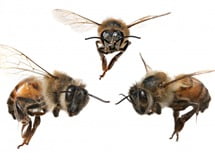WHAT’S so fascinating about the
current research is that Dr Adrian Dyer is one of Australia’s leading bee
experts and his latest research shows that honeybees can learn to recognise
human faces even when seen from different viewpoints. Importantly, the research
could be applied in the areas of new technology, particularly the development
of imaging systems.
“What we have shown is that the bee
brain, which contains less than 1 million neurons, is actually very good at
learning to master complex tasks. Computer and imaging technology programmers
who are working on solving complex visual recognition tasks using minimal
hardware resources will find this research useful,” Dr Dyer said.
“Most current artificial
intelligence (AI) recognition systems perform poorly at reliably recognising
faces from different viewpoints. However the bees have shown they can recognise
novel views of rotated faces using a mechanism of interpolating or image
averaging previously learnt views.”
The findings show that despite the
highly constrained neural resources of the insects (their brains are 0.01 per
cent the size of the human brain) their ability has evolved so that they’re
able to process complex visual recognition tasks.
The researchers individually trained
different groups of free-flying bees with a sugar reward for making correct
choices, or alternatively the bees were punished with a bitter tasting solution
for incorrect choices. Faces were presented on a vertical screen and bees
slowly learnt to fly to the correct target faces. Over the course of a day a
bee brain learned a complex task, and then when tested in non-rewarded tests
(to totally excluded cues like olfaction) only bees that had experience
multiple views (e.g. faces at both 0 degrees and 60 degrees) were able to solve
a novel rotational angle of 30 degrees.
Dr Dyer said the discovery helps to
answer a fundamental question about how brains solve complex image rotational
problems by either image averaging or mentally rotating previously learnt
views.
“Bee brains clearly use image
interpolation to solve the problem. In other words, bees that had learnt what a
particular face looked like from two different viewpoints could then recognise
a novel view of this target face. However, bees that had only learnt a single
view could not recognise novel views,” Dr Dyer said.
The study, performed over two years in Australia and Germany
by Dr Dyer with the support of the US Air Force Office of Scientific Research
(AFOSR), and Dr Quoc Vuong from Newcastle
UniversityUK,
was published in the science journal PLoS ONE.
“The relationships between
different components of the object often dramatically change when viewed from
different angles but it is amazing to find the bees’ brains have evolved clever
mechanisms for problem solving which may help develop improved models for AI face
recognition systems,” Dr Dyer said.
Such systems would be a boon in the
electronic security industry where the challenges faced by fixed angle cameras
when viewing faces at varying angles has pushed face recognition aside as a
real world biometric and investigative technology.








